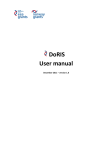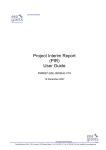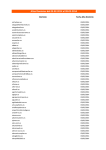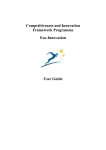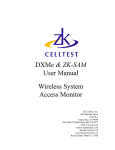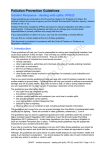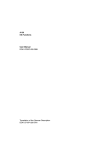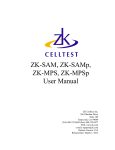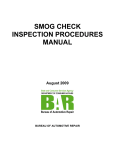Download Application Form User Guide
Transcript
eea financial mechanism Application Form User Guide Version 3, published 14 July 2006 This Application Form User Guide is written for version 3 of the application form. Make sure that the version numbers of the application form and user guide correspond. norwegian financial mechanism Financial Mechanism Office, 12/16, Rue Joseph II, 1000 Brussels, Belgium . Tel: +32 (0)2 286 1701 . Fax: +32 (0)2 286 1789 . Email: [email protected] . www.eeagrants.org Page 2 of 17 INTRODUCTION................................................................................................................................................................ 4 TIPS AND ADVICE ............................................................................................................................................................... 4 APPLICATION FORM ........................................................................................................................................................... 4 SUBMISSION OF APPLICATIONS......................................................................................................................................... 5 REQUIRED DOCUMENTS: .................................................................................................................................................... 5 PART I TO BE COMPLETED BY THE APPLICANT ................................................................................................. 6 TITLE OF THE PROJECT................................................................................................................................................. 6 BENEFICIARY STATE ...................................................................................................................................................... 6 MAIN PRIORITY SECTOR COVERED BY THE OPERATION ................................................................................. 6 SUMMARY ........................................................................................................................................................................... 6 1. APPLICANT..................................................................................................................................................................... 6 1.1 NAME AND CONTACT DETAILS .................................................................................................................................... 6 1.2 DESCRIPTION OF THE APPLICANT .............................................................................................................................. 6 1.3 SOURCE OF INFORMATION FOR THE AVAILABILITY OF GRANTS ................................................................................ 7 2. TYPE OF APPLICATION.............................................................................................................................................. 7 3. TYPE OF PROJECT ASSISTANCE........................................................................................................................... 7 4. DESCRIPTION OF THE PROJECT............................................................................................................................ 8 4.1 PROJECT DESCRIPTION, WITH BACKGROUND AND JUSTIFICATION ........................................................................... 8 4.2 ACTIVITIES AND SCHEDULE ........................................................................................................................................ 9 4.3 OBJECTIVES AND INDICATORS ................................................................................................................................... 9 THREE LEVELS OF OBJECTIVES SHOULD BE IDENTIFIED IN THE TABLE IN THE APPLICATION FORM: RESULTS, PURPOSE AND OVERALL OBJECTIVE. ................................................................................................................................................ 9 4.4 MANAGEMENT (ALL TYPES OF PROJECT ASSISTANCE) ........................................................................................... 10 4.4.1 Management structures during the implementation, including financial management ............................. 10 4.4.2 Partnership........................................................................................................................................................ 10 4.5 OTHER GRANT APPLICATIONS MADE ........................................................................................................................ 11 4.5.1 Preparation support (including seed money fund)......................................................................................... 11 4.5.2 EU funding for this project.............................................................................................................................. 11 4.5.3 Other applications............................................................................................................................................. 11 5. FINANCE AND BUDGET............................................................................................................................................ 11 5.1 KEY PROJECT PARAMETERS..................................................................................................................................... 11 5.2 EXPENSES ................................................................................................................................................................. 12 5.3 ELIGIBLE EXPENSE FUNDING .................................................................................................................................... 13 5.4 ADDITIONAL BENEFITS .............................................................................................................................................. 13 5.5 REVENUE GENERATING PROJECT ............................................................................................................................ 13 6. LEGAL ISSUES RELEVANT TO THE PROJECT................................................................................................. 13 6.1 COMPLIANCE WITH EU LEGISLATION ....................................................................................................................... 13 6.2 IMPLEMENTATION OF EU LEGISLATION .................................................................................................................... 13 6.3 COMPLIANCE WITH NATIONAL, REGIONAL OR LOCAL DEVELOPMENT STRATEGIES ............................................... 13 6.4 LEGAL CHALLENGES OR PROCEDURES .................................................................................................................... 14 6.5 CERTIFICATES AND PERMITS .................................................................................................................................... 14 7. PUBLICITY .................................................................................................................................................................... 14 8. RISKS AND RISK MANAGEMENT .......................................................................................................................... 14 Financial Mechanism Office, 12/16, Rue Joseph II, 1000 Brussels, Belgium . Tel: +32 (0)2 286 1701 . Fax: +32 (0)2 286 1789 . Email: [email protected] . www.eeagrants.org Page 3 of 17 9. CROSS-CUTTING ISSUES ........................................................................................................................................ 14 9.1 SUSTAINABLE DEVELOPMENT................................................................................................................................... 14 9.1.1 Environmental .................................................................................................................................................. 14 9.1.2 Economic........................................................................................................................................................... 15 9.1.3 Social ................................................................................................................................................................. 15 9.2 GENDER EQUALITY.................................................................................................................................................... 15 9.3 GOOD GOVERNANCE ................................................................................................................................................ 16 10. BILATERAL RELATIONS ........................................................................................................................................ 16 11. SUPPORTING DOCUMENTS ................................................................................................................................. 16 12. SIGNATURE................................................................................................................................................................ 17 PART II TO BE COMPLETED BY THE FOCAL POINT ......................................................................................... 17 Financial Mechanism Office, 12/16, Rue Joseph II, 1000 Brussels, Belgium . Tel: +32 (0)2 286 1701 . Fax: +32 (0)2 286 1789 . Email: [email protected] . www.eeagrants.org Page 4 of 17 INTRODUCTION This guide for completing the application form for the EEA Financial Mechanism and the Norwegian Financial Mechanism gives instruction on the individual points in the application form. By following the procedures described below, the applicant will ensure that there is a sound basis for an appraisal of the application and speed up the decision-making process. The financial mechanisms offer several different types of assistance to allow end-recipients in the beneficiary states more flexibility and greater possibilities. Assistance may be awarded in the form of support for individual projects, programmes (groups of projects), block grants or NGO funds. The different types of assistance are described in the Rules and procedures of the financial mechanisms and in separate guidelines. These documents can be found on the website www.eeagrants.org Due to this flexibility, the application should be supported by additional documentation according to the nature of the proposal, with the application form summarising the key characteristics of the project. Each beneficiary state has made use of its right to supplement the application procedure – thus the national websites should be consulted for specific information referring to a particular call. For a list of the websites, refer to www.eeagrants.org. This guide refers to the application form for assistance to individual projects, programmes, block grants and NGO funds. This guide does not cover applications for grants under an established programme, block grant or NGO fund. For such applications, the intermediary is responsible for the implementation of relevant application forms and the selection of the projects. The application, any supporting documents, and information provided therein, may be made publicly available according to the freedom of information acts of the EEA-EFTA states. Tips and advice Study the key documents available on www.eeagrants.org and on the website of the relevant Focal Point and make sure that your project meets the eligibility criteria Be clear about the objectives of your project: what, when, why and how Demonstrate the need for the project and demonstrate how it responds to that need Base the budget on comparable projects and relevant documentation such as offers, prices, indexes, etc. and justify the costs in question Make sure that the application form is fully completed and verify the accuracy of the information Make sure to attach any additional details and background information that may be needed for an efficient appraisal Use simple language, define abbreviations and avoid using specialist jargon Prepare the proposal thoroughly and submit only when ready for financing Make sure that none of the cells in the application form are red Contact the relevant Focal Point or the appropriate Intermediate Body if you have further queries both regarding the financial mechanisms and any country specific implementation requirement. The Financial Mechanism Office (FMO) can also be at your service. All contact details are available on www.eeagrants.org Application form The application form is a standard Excel workbook that should be compatible with Microsoft Excel 97 and any later versions. Once the workbook has been opened, there are three sheets (forms) available that can be accessed by clicking the "tabs" at the bottom. (Terms, Applicant, Focal Point). You can move easily through the forms by using the mouse and the scroll-bar at the right side of the screen. The forms must never be modified except for the fill-in areas. All fields to be filled in are coloured light blue. To avoid loss of information on the printout, do not exceed the size of the fill-in boxes, even if the application form allows you to type beyond this point. You are not obliged to fill in all the text boxes in full – in some cases parts of the form might not be applicable for your application. Do not forget to save the file regularly as you progress. In case of problems or error messages, contact the relevant Focal Point. Financial Mechanism Office, 12/16, Rue Joseph II, 1000 Brussels, Belgium . Tel: +32 (0)2 286 1701 . Fax: +32 (0)2 286 1789 . Email: [email protected] . www.eeagrants.org Page 5 of 17 Submission of applications Applications are submitted usually only as a response to an open call. The Financial Mechanism Office will only accept applications forwarded by the Focal Points. For information on the submission of applications, contact the Focal Point of the relevant beneficiary state or consult the Focal Point’s website. Required documents: Completed application form (Part I by the applicant and Part II by the Focal Point) Supporting documentation The applicant submits the application to the Focal Point or the authority designated by the Focal Point both in electronic form and in hard copy. No changes should be made to the original settings of the electronic version of the application form submitted. Ensure that the hard copy is identical to the electronic version. However, only the hard copy needs to be officially signed by the applicant. The hard copy should be unbound and all pages must be of A4 size and one-sided. The application form and any necessary supporting documents will be forwarded to the Financial Mechanism Office by the Focal Points following a national selection and assessment process, and they must – at the latest by that time - be in English. All monetary units used in the application form and in supporting documentation must be in euros. Only integers should be used. Ensure that you have fulfilled the requirements listed below before submitting the application to the Focal Point or to the authority designated by the Focal Point: The standard format of the application form has been used and no amendments have been made to the text of the form (protected fields). The electronic and hard copy versions are identical and include all supporting documents. Note that only electronic versions in Word, Excel and PDF-formats will be accepted. All financial data are in euros. All inputs to tables containing financial and numerical information are correct. The hard copy is duly signed and dated. All necessary and listed supporting documents are attached and clearly numbered. Financial Mechanism Office, 12/16, Rue Joseph II, 1000 Brussels, Belgium . Tel: +32 (0)2 286 1701 . Fax: +32 (0)2 286 1789 . Email: [email protected] . www.eeagrants.org Page 6 of 17 PART I TO BE COMPLETED BY THE APPLICANT Title of the project The title of the project should be descriptive, practical and short. The title should refer to the geographical location and the purpose (keywords). Beneficiary state Select the beneficiary state from the drop-down menu. Main priority sector covered by the operation The applicant must select the most appropriate priority sector from the drop-down list that to his/her mind best matches the main objective of the project. However, the project may cover other sectors in addition to the main sector. Summary Provide a short summary of the information given in this application form (maximum one page). You may consider writing the summary once the application form is fully completed. In the summary, the following types of information should be mentioned in short: Background of project Location of project Objective statement (purpose or overall objective) A project description which should include main activities and timeframe Other relevant information of key importance This section should not be used as an index of the contents of the application form or of the attachments. 1. Applicant 1.1 Name and contact details Provide the full legal name and the registered address of the applicant. The applicant must be a legally established entity in the beneficiary state in which it submits the application. Provide contact details of a contact person with whom the application can be discussed. Make sure to provide only one contact e-mail address. In case of several e-mail addresses entered into this field, the cell will turn red. The person signing the application on behalf of the applicant in section 11 does not have to be the same person as the contact person in section 1. Add the contact address only if different from the registered address. 1.2 Description of the applicant Give a concise description of the applicant. The description should cover the following key issues: brief background of the organisation, including an indication of its owner, where applicable; main activities at present; management structure and resources (including funding); and Financial Mechanism Office, 12/16, Rue Joseph II, 1000 Brussels, Belgium . Tel: +32 (0)2 286 1701 . Fax: +32 (0)2 286 1789 . Email: [email protected] . www.eeagrants.org Page 7 of 17 experience in managing similar projects. Attach last year’s annual report, financial statements, etc. as appropriate. The Focal Point will carry out essential checks (legal and tax status, etc.) under beneficiary state legislation on the eligibility of the applicant. The documents required vary according to each beneficiary state, and therefore it is not possible to provide an exhaustive list of required documents here. Follow the instructions given by the Focal Point in the relevant beneficiary state for further guidance. 1.3 Source of information for the availability of grants Select from the drop-down menu the most appropriate answer to how you first learned about the opportunity to apply for EEA Financial Mechanism / Norwegian Financial Mechanism grants. 2. Type of application Select project outline or complete application from the drop-down menu as appropriate. Unless the Focal Point has decided to accept project outlines, the option ‘complete application’ must be selected. Complete application A complete application must include all information relevant to the decision–making process of the Focal Point and necessary as basis for an appraisal to be organised by the Financial Mechanism Office. Accordingly, all parts of the application form must be completed. If the applicant considers a certain part of the form irrelevant for the project in question, the applicant must state that and explain why this is the case. Outline application For project outlines the Focal Point and/or Financial Mechanism Office will give a preliminary assessment of the compatibility of the project with Protocol 38a on the EEA Financial Mechanism and/or with the Agreement on the Norwegian Financial Mechanism, the Rules and procedures and the guidelines. The information given in an outline is expected to be less comprehensive than in a complete application. For the outline application, the applicant does not have to fill in the following sections of the application form: 6. 7. 11. Legal issues relevant to the project Publicity Supporting documents For the outline application, the following two sections must be completed, but the information given in the outline could be less detailed than in a complete application: 4.3 5.2 Objectives and indicators Expenses 3. Type of project assistance The EEA Financial Mechanism and the Norwegian Financial Mechanism provide different types of project assistance; select the appropriate one from the drop-down menu: Individual project An individual project is an economically indivisible series of works fulfilling a precise technical function and with clearly identifiable aims. An individual project may include one or more subprojects. All elements of the individual project, including any sub-projects, must be clearly identified. Programme (group of projects) A programme consists of sub-projects linked by a common theme or shared objective proposed at the regional, sub-regional or local level, or by specific national themes. It is intended to facilitate the implementation of more comprehensive and cost-intensive strategies. Programme applications are Financial Mechanism Office, 12/16, Rue Joseph II, 1000 Brussels, Belgium . Tel: +32 (0)2 286 1701 . Fax: +32 (0)2 286 1789 . Email: [email protected] . www.eeagrants.org Page 8 of 17 submitted and implemented by programme intermediaries. Programme applications shall give a detailed and comprehensive account of all aspects of the proposed programme; its main objectives, an indication of the project activities that will form the programme, and a delivery plan with proposed implementation arrangements including criteria and procedures for selection of sub-projects. Block grant A block grant is a fund, set up for a clearly defined purpose that may be used to provide assistance to individuals, organisations or institutions. Block grants are intended to facilitate the implementation of sub-projects that are too small to be identified a priori or to be administered cost-effectively on an individual basis. Block grants are implemented by a block grant intermediary. Block grant applications shall include the proposed selection criteria and procedures for approval of grants. NGO fund An NGO fund is set up to provide grants to NGOs and the social partners. The grant assistance is adapted to the needs of the end-recipients, including a smaller size of project, the need of independence from government structures, and the need to make the application process simpler and faster. The fund is operated by an intermediary that will normally have close ties with the NGO community in the beneficiary state and possess grant management experience. The fund should support the priority areas of the financial mechanisms as well as strengthen civil society or individual NGOs in the beneficiary state. NGO fund applications shall include the proposed selection criteria and procedures for the approval and monitoring of grants. For further details on different types of project assistance, refer to the guidelines available on the website of the FMO. If the application concerns the establishment of a new programme, block grant or NGO fund, complete the separate document on management arrangements specific to such applications (“Fund set-up”) and attach it to the application. 4. Description of the project 4.1 Project description, with background and justification Explain the origins and outline why the project should be undertaken, and identify clearly the main problem that the project shall solve or contribute to solve. Give an overall description of what the project is about and how it will be implemented. Describe the target groups of the project. Explain the feasibility of the project and why the described approach has been chosen as the most appropriate. This description should include the choice of best available technology (when appropriate) and the cost-benefit in relevant comparison. When relevant, a description of whether the polluter pays principle has been followed is required. If the project is an independent part of a larger project, operation or overall strategy, explain the links between activities already completed, activities to be carried out under these funds, and any activities planned in the future. It is generally useful if an applicant attaches a short feasibility study. It may cover, among other things: socio-economic context technological alternatives financial analysis risk analysis logical framework matrix The applicant must use judgement in determining the scope of such a study. In programmes, block grants and NGO funds, a needs analysis may be more appropriate. This may include some of the elements of a feasibility study but would concentrate on a description of the context and the forecast development of the Financial Mechanism Office, 12/16, Rue Joseph II, 1000 Brussels, Belgium . Tel: +32 (0)2 286 1701 . Fax: +32 (0)2 286 1789 . Email: [email protected] . www.eeagrants.org Page 9 of 17 area of intervention to be addressed. Such studies often provide the basis for relevant indicators in section 4.3. In some cases only a few of the normal topics for such a study may be relevant, such as e.g. a risk analysis (see also section 8 about risk). Give relevant details of the geography of the project (national, regional, sub-regional, municipal or any other). When necessary, attach a map or any relevant conceptual illustration, such as an overall lay-out, drawings or photos related to the project. 4.2 Activities and schedule Include those project activities that are to be directly co-financed from this grant. Select a target start date of the project from the drop-down menu (month, year) and indicate as well the planned duration of the project (in months). Note that it can take approximately 6 to 12 months between the closing date of the call and the grant decision – this aspect is to be taken into consideration when the target start date is selected. Break down the project into distinct activities. Limit the number of activities to maximum 10. For most projects, this is more than sufficient, however in exceptional cases when the project needs to be divided into more than 10 activities, combine activities in a logical way in order to fit the format and give the details on in an attachment. For each activity give a concise description which include: Activity name and scope Start month, expressed as an ordinal number of the month compared to the planned start month (e.g. if the project is planned to start in January 2006, activity 1 starts in January 2006, activity 2 in October 2006 and activity 3 in March 2007, the start month for activity 1 is 1, for activity 2 is 10, and for activity 3 is 15) Estimated duration, expressed as number of months Estimated expenses in euros, including the sum of cash eligible expenses, the value of in-kind eligible expenses and non-eligible expenses The total expense is added up automatically from the expenses entered under the activities. This sum must be equal with the total project expenses from the table in section 5.2. If not, the cell Total expense will turn red. 4.3 Objectives and indicators Three levels of objectives should be identified in the table in the application form: Results, Purpose and Overall Objective. Overall objective is the consequence of the project beyond the immediate effects to its direct beneficiaries. The overall objective can usually only be measured when some time has passed, typically 2-5 years after completion. The overall objective should be linked to the project as directly as possible. A few examples of overall objectives: for a kindergarten, the overall objective may be to enable a larger part of women in a community to engage in paid work; for a wastewater treatment plant, the overall objective may be to reach a certain level of water quality measured as minimum oxygen level in a lake; for an education project, the overall objective may be to achieve a certain level of efficiency in a municipal administration. Purpose is the expected outcome of the project, such as number of museums opened, tonnes of reduced CO2 equivalents per year, number of jobs directly created, etc. The purpose is the reason for why the activities were carried out, and it is usually the combination of the results that determine the purpose. For example the combination of m2 walls and floors etc produced in the project will at the completion be used as a kindergarten for 45 children, which is the purpose. It shall normally be possible to measure or identify the achievement of the purpose at the completion of the project. Financial Mechanism Office, 12/16, Rue Joseph II, 1000 Brussels, Belgium . Tel: +32 (0)2 286 1701 . Fax: +32 (0)2 286 1789 . Email: [email protected] . www.eeagrants.org Page 10 of 17 Results are the direct products of the project, such as square meters of building refurbished, numbers of training places created, businesses advised, etc. The results can usually be measured during the project implementation and will therefore serve as progress indicators. Each result may be linked to an activity described in 4.2 above. All results must be measurable and achieved at the latest by the completion of the project. In the first column of the table, give a short statement on each level. One overall objective, one purpose and up to three results are possible. In the second column, define up to three indicators per statement. This definition must be short and clear and also include the unit of the indicator such as e.g. number of, m2, Mg (tonne) etc. The third column is for the baseline value of each indicator chosen. This is the status prior to the implementation of the project. If needed, applicants may provide further explanations and calculation methods in an attachment. The fourth column is for the target value of the chosen indicators. This is the expected value to be achieved as a consequence of the project. In the baseline and target columns only numerical values can be entered. Applicants should always provide quantifiable targets for indicators for Results and Purpose. If Overall Objective indicator targets can be quantified realistically, then this should be done as well. To quantify overall objectives may sometimes be difficult and may require some creativity, however, it should in most cases be possible. For those cases where this is deemed impossible, the third and fourth column may be left blank in case of the overall objective. The objectives and indicators table has a restricted number of possible objectives and indicators. If a larger number is relevant, choose the most important ones, and the ones that – in combination – cover as much as possible of the project. Feel free to give further objectives and indicators in an attached document. A further illustration of the use of indicators and how to fill in the above table is given in the document Examples of indicators, where examples are given and grouped according the priority sectors of the EEA Financial Mechanism and the Norwegian Financial Mechanism, available at the FMO website. The indicators are also often influenced by other circumstances than the project itself, especially on the overall objective level. 4.4 Management (all types of project assistance) 4.4.1 Management structures during the implementation, including financial management Describe the co-ordination and management structure of the project. Outline clearly the structure, responsibilities and procedures for the management and co-ordination of the project. If needed, illustrate the management structures in an organisational chart or flow-chart and attach it to the application. The description should include a brief explanation of the arrangements in place for the financial management of the project, including arrangements for reporting, monitoring and auditing. 4.4.2 Partnership Indicate whether the application is made with respect to a partnership. Where an applicant indicates a partnership, he/she is applying on behalf of itself and other organisations and/or institutions that make up the partnership and will implement specific tasks in the proposed project. Describe the role and added value that each partner brings to the project. Project partners’ expenses are normally fully or partially reflected in the project budget. This section is not intended as a place to describe other stakeholders involved in an indirect way in the project. Contractors providing goods or services usually need to be selected through public procurement and normally have yet to be identified. Financial Mechanism Office, 12/16, Rue Joseph II, 1000 Brussels, Belgium . Tel: +32 (0)2 286 1701 . Fax: +32 (0)2 286 1789 . Email: [email protected] . www.eeagrants.org Page 11 of 17 4.5 Other grant applications made 4.5.1 Preparation support (including seed money fund) State if the development of the application has been financed with seed money or other grant funding. If yes, specify the source(s) and amount(s). If seed money has been provided by a seed money facility funded by the EEA Financial Mechanism and/or the Norwegian Financial Mechanism, provide the date of application and/or grant offer letter. 4.5.2 EU funding for this project Explain whether applications for any EU funding have been made or have been successful with respect to this project or with respect to other projects closely linked to this project. Explain the reasons for rejection (if known). Provide details of the amount applied for. If any such applications were approved, indicate the grant amount(s) and specify the EU funding source(s). 4.5.3 Other applications Explain whether applications to donors other than the EU (international or national financial institutions, or others) have been made with respect to the project in question or with respect to other projects closely linked to this project. If yes, specify the donor(s) and explain the result of the application(s) (approved/rejected). Provide details of the amount applied for and the reasons given for any rejections. If any such applications were approved, indicate the grant amount(s) and the source(s) of the support. 5. Finance and Budget 5.1 Key project parameters The targeted start date in section 4.2 must be completed before completing this section of the application form. Indicate the exchange rate used in the budget preparation. If the application is submitted in respect of an open call, the exchange rate to be used is the one published in the open call. The financial information must be given in euros. It is also required that the applicant indicate the total cash co-financing in euros from the central, regional or local government budget allocations and from non-public sources. The total sum from the fields ‘Grant requested’, ‘Total cash co-financing – central, regional or local government budget’ and ‘Total cash co-financing – non-public source’ must correspond with the field ‘Total cash outflow’ in the table ‘Cash Eligible Expenses – Euro’ in section 5.2. If the cells turn red, then there is a discrepancy. For further information on co-financing rules, see article 3.2.1 of the Rules and procedures. For individual projects and programmes, an advance payment of up to 10 percent of the grant awarded may be made if justified by the applicant and deemed necessary by the Financial Mechanism Committee and/or the Norwegian Ministry of Foreign Affairs. Block grants and NGO funds may also take advantage of advance payments. A request for an advance payment, its justification and type of offset mechanism (selected from the drop-down menu) must be included in this section. The advance offset mechanism to be applied for the project can take one of four forms: 1. The whole advance is set off against the first payment claim 2. The advance is set off in equal proportions from the first payment claim until 80% of the grant has been spent 3. The whole advance is set off when 80% of the grant has been spent 4. Manual advance offset scheduling The first three of these are predefined offset mechanisms which are to be applied in most cases. The fourth provides the applicant with the opportunity to request a different form of offset schedule. The advance offset Financial Mechanism Office, 12/16, Rue Joseph II, 1000 Brussels, Belgium . Tel: +32 (0)2 286 1701 . Fax: +32 (0)2 286 1789 . Email: [email protected] . www.eeagrants.org Page 12 of 17 mechanism to be applied to the project must be approved by the donors. The applicant should, however, indicate his/her preferences here. Select ‘No advance payment required’ if advance payment is not necessary for the project. Specific examples of the four advance offset mechanisms are provided on the FMO website. 5.2 Expenses Cash eligible, in-kind eligible and non-eligible expenses must be separated as indicated in the budget table. It is obligatory to attach a detailed budget to the application form. The totals from the attachment must correspond with the totals in the budget table. Cash eligible expenses The section provides one row exclusively for management costs, four rows for already predefined expenses (to be selected from the drop-down menu), and if the expenses cannot be described under any of the above mentioned categories, the applicant may include a maximum of four other descriptions. Management costs refer to expenses for additional dedicated management structures, with staff hired exclusively for the project’s management tasks during the period of project implementation. For further details on this type of expenses, refer to article 2.5 in the Individual Project guideline, Programmes (group of projects) guideline, Block Grants guideline and article 2.4 in the NGO Grant guideline. Predefined expenses (from the drop-down menu) include the following expenses: Labour refers to salaries, all benefits, as well as social security and any other taxes for the individuals working on the project, but which are not part of the management costs mentioned above Services refer to expenses which are limited to the “soft type” of services, e.g. consultancy, studies, teaching, marketing etc. Office expenses refers to expenses that cannot be identified readily and specifically with a particular activity, e.g. office supplies and equipment, travel expenses, petty expenses Equipment refers to capital expenses for equipment directly allocable to the project activities Raw materials refers to expenses for material which is used in the project, e.g. steel, concrete, wood or any other substance / products out of which something can be made or used in order to achieve the objectives of the project Building acquisition refers to expenses for purchase of real-estate Land acquisition refers to expenses for purchase of land Contractors refers to expenses related to physical work e.g. construction, renovation, excavation, repairs etc. Publicity refers to expenses which are related to project information and/or publicity measures In-kind eligible expenses The section provides one row for in-kind eligible expenses from central, regional or local government budget allocations and one row for in-kind eligible expenses from a non-public source. The value of the in-kind contribution must be filled in here and the nature of the in-kind must be described below in the remarks field. For further details on in-kind contributions, visit article 2 in the Detailed eligibility provisions – expenditures. Non-eligible expenses Define and explain the non-eligible expenses directly linked to the project. The eligibility of different types of expenditure is defined in the Detailed Eligibility Provisions – expenditures. Indicate whether the applicant can recover VAT expenses incurred – ‘yes’ or ‘no’ must be selected from the drop-down list. Financial Mechanism Office, 12/16, Rue Joseph II, 1000 Brussels, Belgium . Tel: +32 (0)2 286 1701 . Fax: +32 (0)2 286 1789 . Email: [email protected] . www.eeagrants.org Page 13 of 17 5.3 Eligible expense funding This section summarises information provided by the applicant in sections 5.1 and 5.2 of the application form. You cannot change information in this part of the Form directly. If cells in this section have turned red, this indicates that there is a discrepancy between “Project expenses” in 5.2 and “Total cash and in-kind contribution” in 5.1, and you must review and amend the data in those sections. 5.4 Additional benefits The applicant should provide a statement of additional benefits to the project through the approval of the grant. The appropriate statement is to be selected from the drop-down menu. If the applicant estimates that the project would proceed without the grant, but in a reduced way, the applicant must explain to what extent the project would be limited without receiving the grant. If the applicant estimates that the project would proceed, but would take longer to finish, the applicant must explain the change in timescale and the impact this will have on the project’s success. If the applicant estimates that project would proceed as planned without the grant, the applicant must explain why the project should benefit from the grant. 5.5 Revenue generating project Specify whether the project is revenue-generating or not – ‘yes’ or ‘no’ must be selected from the drop-down list. In case of a revenue-generating project, the table should be completed with the expected revenues and operating expenses during the economic lifetime of the project. All the other figures are calculated automatically. The standard profit margin is predefined, it equals to the previous year’s average of monthly average 10 years Government bond interest (or equivalent) in the beneficiary state + 2 %. For further details on revenue generating projects, check the Revenue generating projects guideline. 6. Legal issues relevant to the project 6.1 Compliance with EU legislation Provide a statement on the arrangements made to ensure compliance with EU legislation relevant to the project. The statement must cover at least the following areas of EU legislation: state aid rules public procurement rules environment If the project involves state aid aspects, give details such as the amount of state aid, whether de minimis rule applies, whether the state aid is registered in a scheme or on ad hoc basis, provide number of notification, reference to the letter of approval by the Commission, etc. EU legislation related to state aid is a complex issue and applicants are advised to contact the Focal Points for guidance if needed. As for public procurement, a general statement on the arrangements foreseen should be provided, and a general description of types of contracts (e.g. studies, works, supplies or services) and the award procedures may also be added. Where any such procedures have already started, provide information on the status. As for EU legislation in the field of environment, the applicant should refer to the legislation relevant to the project (e.g. Environmental Impact Assessment Directive 85/337/EEC (as amended)). For programmes, block grants and NGO funds it may be necessary to refer to the Strategic Environment Assessment directive 2001/42/EC. 6.2 Implementation of EU legislation If the project has been developed with the aim of contributing to the implementation of certain EU legislation, then specify the Directive or Regulations in question and explain what impact you hope the project to achieve. 6.3 Compliance with national, regional or local development strategies Explain how the project will support strategies adopted at a national or regional level in the beneficiary state, to the extent that these are relevant to the project’s objectives. Financial Mechanism Office, 12/16, Rue Joseph II, 1000 Brussels, Belgium . Tel: +32 (0)2 286 1701 . Fax: +32 (0)2 286 1789 . Email: [email protected] . www.eeagrants.org Page 14 of 17 6.4 Legal challenges or procedures State whether the successful implementation and completion of the project is dependent on the outcome, positive or negative, of any legal challenges or procedures within the jurisdiction of the beneficiary state, the European Community, international courts or tribunals, or any other state. The term 'legal challenges or procedures' is to be understood to include any unresolved legal disputes even when no formal procedures have been initiated. If yes, provide the relevant details. 6.5 Certificates and permits List any permits or certificates required before and/or during the implementation of the project. Provide a clear reference to the permit/certificate (including any reference number). Indicate the date on which the permit/certificate was obtained and its period of validity (if this is limited). Provide an estimated date on which the permit / certificate will be applied for. Examples of permits and certificates include building permits, decisions issued by heritage conservation offices or environmental protection offices, etc. 7. Publicity An information and publicity plan should be prepared by the applicant and should be included in the application. The plan should include a brief description of aims and target groups, implementation measures and methods, budget (check that it is the same as in the detailed budget breakdown) and responsibility for implementation. Refer to the requirements set out in the Publicity guideline. If the space provided in the application form is insufficient, attach the publicity plan to the application form. 8. Risks and risk management Generally, any project will have associated risks and these risks must be managed properly. Accordingly, it is important to recognise such risks and plan how to manage the risk factors. Risks could be related to funding sources, permissions, procurement issues, etc., and they could be technical, financial, legal or managerial. A risk analysis must identify the risks, including considerations of likelihood and impact, as a basis to determine how risk should be managed. Both likelihood and impact can have three values (low, medium or high) to be selected from a drop-down list. It will typically include, but not be limited to, the relation between risks and objectives, judgement of critical risks and determination of actions to mitigate risks. Provide a separate risk analysis if applicable (may be part of a feasibility study, see 4.1). 9. Cross-cutting issues Cross-cutting issues address various values/aspects of the project relevant for all sectors, and are important in relation to the overall quality of the application. The cross-cutting issues are essential parts of the primary goal of the financial mechanisms, the reduction of social and economic disparities in the European Economic Area (EEA). The applicant must consider cross-cutting issues when applying for grant assistance and provide information on how they relate to the application. If a particular cross-cutting issue is considered not to be relevant, a justification for this must be provided. 9.1 Sustainable development In this section the applicant is asked to describe how the project contributes to sustainable development which integrates the environmental, economic and social dimensions of human endeavour into a single, comprehensive concept. The listed questions illustrate various aspects of sustainable development within each of the three dimensions as they may relate to project applications. The applicant should consider and provide comments on these issues as relevant. Note that the questions are not exhaustive. For further information on sustainable development in the financial mechanisms, see the Sustainable development policy and guide. 9.1.1 Environmental Describe how the project will contribute to environmental sustainability and how any possible adverse environmental impact will be rectified. If relevant, an environmental impact assessment must be attached. The issue regarding the environmental dimension is to determine whether or not the project has a positive Financial Mechanism Office, 12/16, Rue Joseph II, 1000 Brussels, Belgium . Tel: +32 (0)2 286 1701 . Fax: +32 (0)2 286 1789 . Email: [email protected] . www.eeagrants.org Page 15 of 17 environmental impact and how the key aspects of environment have been considered. Some general questions to consider are Does the project respect the principles of preventive action? How have green procurement targets been included for the project? More specifically and depending on the nature of the project, one or more of the following questions may be answered: To what degree will the project reduce or prevent emission of persistent toxic pollutants? Will the project result in the recovery of natural resources? Is use of fossil energy reduced by the project? Is the project of benefit to biodiversity? 9.1.2 Economic Describe how the long-term economic viability of the project will be ensured. How, when and by whom will the results be used? How will the purpose of the project be maintained? Explain how operating and maintenance expenses will be covered after project implementation is completed. Where relevant, explain whether a fund exists or will be established to secure against unexpected expenses related to the maintenance and operation of the project results. It is also important to determine that the economic drivers that influence the project are sustainable and whether or not the project in itself make any kind of contribution for establishment of economic tools for sustainable development. Does the project strengthen financial tools for ecosystem protection? Have the costs of all ecosystem effects been taken into consideration? Are all the financial drivers of the project sustainable? Has the polluter pays principle been followed? 9.1.3 Social The social related checkpoints relate to the knowledge and conduct of the population, their health and integrated sustainable development management. Will the project increase public understanding of sustainability? Will the project influence citizens’ sustainability behaviour positively? Will the project have positive effects for public health? Does the project contribute to more integrated policy, planning or management, for sustainable development? In what way does the project contribute to the ‘social dialogue’ (meaning both the dialogue between the trade unions and employers’ associations, as well as the dialogue between government, local government and civil society organisations)? Will the project contribute to poverty reduction? In addition, summarise measures taken to include disadvantaged groups, such as direct involvement in project design, accessibility to project results etc., or summarise possible social disadvantages and how they will be rectified. 9.2 Gender equality In this section the applicant is asked to describe how the project contributes to gender equality, participation and empowerment. The following list of examples illustrates the various aspects of gender equality as they may relate to project applications. The applicant should consider and provide comments on these issues as relevant. Note that this list is not exhaustive. For further information on gender equality in the financial mechanisms, see the Gender equality policy and guide. General methodology Does the project take into account gender specific needs and address gender specific conditions? Financial Mechanism Office, 12/16, Rue Joseph II, 1000 Brussels, Belgium . Tel: +32 (0)2 286 1701 . Fax: +32 (0)2 286 1789 . Email: [email protected] . www.eeagrants.org Page 16 of 17 Does the project take past experiences and/or current gender equality activities in the country into account? Does the project address the gender equality issues and targets relevant to the project? Does the project provide qualitative information on gender issues where necessary? Economic and social rights Does the project encourage lifelong learning and access by women to the labour market? Does the project enhance the income earning opportunities of women? Does the project strengthen social rights and/or contribute to participation in civil life by women? Does the project reduce the social exclusion of women? Human rights Does the project contribute to strengthening organisations and public institutions working to improve the opportunities and rights of women, including NGOs? Prevention of violence Does the project support awareness-raising actions and campaigns empowering women? Participation and decision-making Does the project contribute to participation by women in decision making at both a political and an economic level? Does the project involve male and female stakeholders in the consultative process Does the project promote women’s participation within the project, for example as project staff, members of steering committees? 9.3 Good governance In this section the applicant is asked to describe how the project contributes to good governance in the beneficiary state. The following list of examples illustrates the various aspects of governance as they may relate to project applications. The applicant should consider and provide comments on these issues as relevant. Note that this list is not exhaustive. For further information on good governance in the financial mechanisms, see the Good governance policy and guide. Does the project contribute to better public access to information and/or improved transparency? Does the project improve participation of civil society in decision making processes? In what way does the project deal with the issue of accountability vis-à-vis those affected by the project? In what way does the project take a proactive approach to preventing and dealing with corruption? How has it been determined that the project fulfils a real need? 10. Bilateral relations State whether the project may contribute to the strengthening of relations between the EEA-EFTA states (Iceland, Liechtenstein and Norway) and the beneficiary state. If the implementation of the project involves partners from the EEA-EFTA states, explain the opportunities you hope to gain from their involvement. Where there are no such project partners, are there any other benefits that may stem to the relations with the EEA-EFTA states during the implementation or as a result of the project? Project partners from these countries and the role they will play in project implementation should also be described under section 4.4.2. 11. Supporting documents All supporting documents (attachments) provided with the application must be listed. Number each supporting document clearly. The electronic version of each supporting document should be saved with a file name that makes its identification clear, for example using the attachment number and name. Obligatory supporting document: detailed budget Common supporting documents would be, among other things: feasibility study Financial Mechanism Office, 12/16, Rue Joseph II, 1000 Brussels, Belgium . Tel: +32 (0)2 286 1701 . Fax: +32 (0)2 286 1789 . Email: [email protected] . www.eeagrants.org Page 17 of 17 maps and conceptual illustrations latest verified annual report signed letter of intent or partnership agreement 12. Signature The application form must be signed by a person with the designated authority in the applicant organisation. The signature shall be original (signature stamps, persons signing on others’ behalf, or photocopies are not acceptable). If a decision of a management committee, board of directors or comparable bodies is required to grant the signatory the necessary powers, the original of the decision, signed by the members of the committee or the board, shall be attached to the application (letter of authority for person signing the application). Do not forget to complete the signatory name, position and signature date electronically in the application form. PART II TO BE COMPLETED BY THE FOCAL POINT Part II of the application form is completed by the Focal Point of the country where the applicant is registered. The applicant should leave this part of the form blank. The Focal Point is charged with selecting the best applications from among those received through open calls, or any other applications made as a result of separate agreements between the donors and the beneficiary state. These prioritised applications (consisting both of the application form and of all or some of the attachments prepared by the applicant) are forwarded to the Financial Mechanism Office, in English, for appraisal and recommendation to the donor states. Financial Mechanism Office, 12/16, Rue Joseph II, 1000 Brussels, Belgium . Tel: +32 (0)2 286 1701 . Fax: +32 (0)2 286 1789 . Email: [email protected] . www.eeagrants.org

















